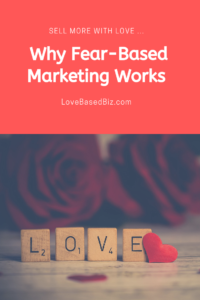If you consider yourself a conscious, heart-centered, mission-driven, spiritual entrepreneur, you may have been horrified when you first learned the basics of traditional copy, marketing, and sales.
There was NO WAY you wanted to use tactics and strategies that felt so hype-y and sales-y and inauthentic in your marketing. Right?
But, what were the alternatives? Not using the power of direct response marketing and copy and sales to promote your business and get your message out into the world? Continuously struggling to gain traction with your business?
That’s exactly why love-based copy is such a hit! It resonated deeply with entrepreneurs who wanted to grow their business in a way that felt good.
The best part is love-based copy DOES work. (My clients have sold nearly $50M using love-based copy and marketing.)
HOWEVER, I think it’s worth pointing out that (at least for the moment), fear-based marketing and sales work, too.
Why?
To start, let’s recap how persuasion works. In order to persuade anyone to do anything (it doesn’t matter if you’re having a sales conversation with a potential client or persuading your kids to go to bed at a decent bedtime), you need to tap into their emotions.
And you have a choice: you can tap into fear-based emotions (including fear, worry, grief, anger, resentment, guilt, shame, etc.), OR you can tap into love-based emotions (love, joy, hope, connection, etc.).
So WHY does tapping into fear-based emotions work? No one wants to feel them, so why would triggering those emotions persuade people to take action?
So, to answer that, let’s dig into how the fear-based emotional cycle works.
For most people, when a fear-based emotion comes up, their first reaction is to do something to stop feeling it.
After all, why would anyone want to feel icky and uncomfortable … or even worse, be STUCK in one of those types of emotions?
So instead, when you have a bad day at work, you go home and open a bottle of wine. You deserve it, right? You had a hard day.
Or, maybe you find yourself digging into the freezer for the ice cream.
Or, maybe you start yelling at your kids even though they really didn’t do anything wrong. Or you go on a shopping spree. Or you call your friends and start gossiping.
The point: Rather than sit and feel those emotions (because emotions just want to be felt, you can’t reason or argue with emotions), you take some sort of action to run away from it, or bury it, or hide from it, or otherwise not feel it.
But, THEN what happens? You wake up with a hangover, your pants are too tight from the ice cream, your credit card is maxed, your kids are crying, or you’re feeling like maybe you went too far with your friends.
You’re remorseful for your actions (which is yet another way to distract yourself from your fear-based emotions).
Okay, so now let’s look at this cycle from a sales and marketing perspective: entrepreneurs or business owners choose to trigger fear in their sales and marketing (some of the most common are fear, or worry about the future, or shame).
The clients don’t want to feel the fear-based emotion. So, they look for an “action” to take to stop feeling the emotion.
And the implicit promise in the sales or marketing conversation is that, if they buy the product or service, the fear-based emotion will go away.
So, they buy. Because they don’t want to feel the fear-based emotion anymore.
And, what happens the next day? They feel buyer’s remorse!
 This is why fear-based marketing may get more initial sales, but you’ll also likely experience a higher percentage of unhappy clients and customers, who may end up:
This is why fear-based marketing may get more initial sales, but you’ll also likely experience a higher percentage of unhappy clients and customers, who may end up:
• Demanding more of your time and energy (and despite your best efforts, are still never happy).
• Disengaging and dropping out.
• Asking for a refund (you almost always get a higher percentage of refund requests using fear-based tactics than love-based).
And over time, fear-based marketing and sales will erode your brand. Because you’re triggering fear-based emotions in your marketing and copy and sales strategies, you’ll end up attracting people who aren’t your ideal clients.
And, since they’re not your ideal clients, they’ll likely not be as happy or satisfied with your program as your ideal clients are. Even if they’re not out there actively complaining about you, there’s still a ripple effect.
Now, contrast that to using love-based marketing and sales. Because you’re not triggering fear-based emotions in a manipulative way, you’re allowing your ideal clients to decide for themselves if they’re ready to make a change. If they do decide to become a client, now they’re committed. They’re not reacting to the fear-based triggers in your marketing, but rather, they’ve dug deep inside themselves and have decided they’re ready to shift.
These are the clients who will show up, do the work, get the results, and tell the world about you.
Which is why, over time, love-based copy and marketing and sales will grow your business in a more organic, word-of-mouth type of way.
Want more on this topic? Check out my “Love-Based Copywriting Method” book.
 How to Succeed as a Writer
How to Succeed as a Writer A Little Secret About Sabotage (Compliments of Cutthroat Kitchen)
A Little Secret About Sabotage (Compliments of Cutthroat Kitchen) 4 Ways to Creatively Power Up Your Marketing
4 Ways to Creatively Power Up Your Marketing Quiz: Where Is Your Marketing Message Hanging Out?
Quiz: Where Is Your Marketing Message Hanging Out? 4 Ways the Love-Based Concept Plays Out in Your Business
4 Ways the Love-Based Concept Plays Out in Your Business
[…] no question that fear is persuasive. The “fear umbrella” includes worry, future-spinning, anxiety, […]